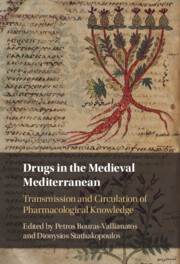Book contents
- Drugs in the Medieval Mediterranean
- Drugs in the Medieval Mediterranean
- Copyright page
- Contents
- Figures
- Tables
- Contributors
- Acknowledgements
- Note to the Reader
- Medieval Mediterranean Pharmacology
- Part I Transmission of Pharmacological Knowledge
- Part II The Borders of Pharmacology
- Chapter 7 Making Magic Happen
- Chapter 8 Remedies or Superstitions
- Chapter 9 When the Doctor Is Not Around
- Chapter 10 Digestive Syrups and After-Dinner Drinks
- Chapter 11 Late Byzantine Alchemical Recipe Books
- Chapter 12 Making Connections between the Medical Properties of Stones and Philosophy in the Work of Albertus Magnus
- Chapter 13 Healing Gifts
- Index
- References
Chapter 10 - Digestive Syrups and After-Dinner Drinks
Food or Medicine?
from Part II - The Borders of Pharmacology
Published online by Cambridge University Press: 19 October 2023
- Drugs in the Medieval Mediterranean
- Drugs in the Medieval Mediterranean
- Copyright page
- Contents
- Figures
- Tables
- Contributors
- Acknowledgements
- Note to the Reader
- Medieval Mediterranean Pharmacology
- Part I Transmission of Pharmacological Knowledge
- Part II The Borders of Pharmacology
- Chapter 7 Making Magic Happen
- Chapter 8 Remedies or Superstitions
- Chapter 9 When the Doctor Is Not Around
- Chapter 10 Digestive Syrups and After-Dinner Drinks
- Chapter 11 Late Byzantine Alchemical Recipe Books
- Chapter 12 Making Connections between the Medical Properties of Stones and Philosophy in the Work of Albertus Magnus
- Chapter 13 Healing Gifts
- Index
- References
Summary
In the medieval Middle East, thinking about health and illness was closely connected to thinking about food and cooking. Can we know what happened in practice? Building on previous research, I will try to show how fine the line was between ‘food’ (or drinks) and ‘medicines’. I examine specific recipes appearing in two books composed in Mamluk-era Cairo – the pharmacopoeia Minhāj al-dukkān and an anonymous cookbook called Kanz al-fawāʾid – to show that some foods were also medicines, and some pharmaceutical preparations were largely food (or rather, snacks!). Comparing and contrasting not only the instructions appearing under the same headings, but also the appearance (or lack thereof) of medical indications, provides information as to which side of the divide given medico-culinary compounds were thought to fall. I also investigate to what extent Kanz al-fawāʾid contains recipes for the foods recommended in the dietetic advice found in some Cairo Genizah prescriptions.
Keywords
- Type
- Chapter
- Information
- Drugs in the Medieval MediterraneanTransmission and Circulation of Pharmacological Knowledge, pp. 320 - 335Publisher: Cambridge University PressPrint publication year: 2023
References
- 1
- Cited by

